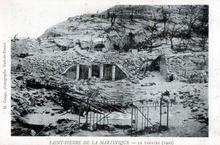Théâtre de Saint-Pierre
This article includes a list of general references, but it lacks sufficient corresponding inline citations. (November 2018) |



The Théâtre de Saint-Pierre, also known as La Comédie, was a theater in Saint-Pierre, Martinique, active from 1786 to 1902. It was a famous center of culture in the West Indies for over a century. Destroyed in the volcano eruption of 1902, its ruins became a historical monument and a site for tourists.
Originally, theatre companies from France performed in temporary localities on tours to Martinique. From 1780, there were demands to the authorities to provide the colony with a permanent theatre. At that point, there were already theatres in the cities of Saint-Domingue since the 1760s and two in Guadeloupe (in Basse-Terre and Pointe-a-Pitre), and a theatre was considered to be an essential hall mark of civilisation and sophistication. The building was designed inspired by the famous Theatre of Bordeaux, and had room for 800 seats. The theatre was described as extremely elaborate and elegant, and became famous in the Caribbean. In the facility, the latest drama, opera and ballets were performed by artists from France. The artists typically stayed no more than a few years or temporary until they continued to Saint-Domingue.
See also
[edit]References
[edit]- Nicolas Maurice: Les grandes heures du théâtre de Saint-Pierre, Berger Imp-Belle page, Fort-de-France, 1974.
- Mark Carroll, Music and Ideology
- Crossroads of Colonial Cultures: Caribbean Literatures in the Age of Revolution
